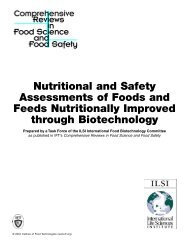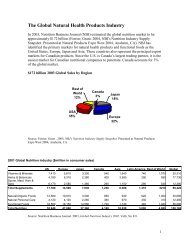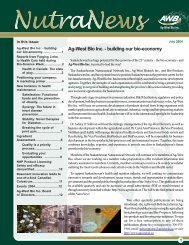Beyond Borders: Global biotechnology report 2010
Beyond Borders: Global biotechnology report 2010
Beyond Borders: Global biotechnology report 2010
You also want an ePaper? Increase the reach of your titles
YUMPU automatically turns print PDFs into web optimized ePapers that Google loves.
John Maraganore of Alnylam<br />
Pharmaceuticals describes a very different<br />
deal structure. His company has been<br />
able to pull off something truly rare — it<br />
has simultaneously signed significant<br />
non-exclusive licensing deals with a<br />
number of pharmaceutical companies.<br />
These deals — which give Alnylam’s<br />
partners access to the company’s small<br />
interfering RNA platform — allow Alnylam<br />
to leverage its platform more broadly than<br />
it could have on its own, by harnessing the<br />
R&D efforts of its partners.<br />
These two deal structures are in stark<br />
contrast to one another. Regeneron’s<br />
deal involves going deep (a long-term<br />
relationship with one partner) while Alnylam<br />
has gone wide, striking non-exclusive deals<br />
with many partners. Yet, there are some<br />
common themes and lessons. The first is<br />
that both were enabled by having strong<br />
platforms. While not every biotech company<br />
is blessed with a compelling platform,<br />
companies looking to attract big pharma<br />
partners at attractive terms will need to<br />
focus on developing strong differentiating<br />
assets. Second, despite being so different,<br />
both deal structures appear to involve less<br />
distraction and more efficient resource<br />
allocation than a series of exclusive deals<br />
with multiple partners, since the companies<br />
are freed up from the operational<br />
challenges involved in managing alliances<br />
with several parties.<br />
For companies looking for creative ways of<br />
partnering with pharma, though, some of<br />
“We can debate the semantics of old<br />
normals and new normals, but for this<br />
industry, dealing with challenges<br />
is the only normal it has ever known.”<br />
the best opportunities may come from the<br />
fact that pharma companies need efficient<br />
solutions in the new normal as much as<br />
biotech companies do. Pharma’s search for<br />
ways to increase the efficiency of its R&D<br />
spending — and the concomitant wave of<br />
out-licensing that may soon follow — could<br />
create tremendous openings for companies<br />
with creative solutions.<br />
The responses and approaches we’ve<br />
discussed so far relate to the business of<br />
biotech — raising funds, operating efficiently,<br />
structuring deals. But <strong>biotechnology</strong> is<br />
ultimately a science-based business, and<br />
more efficient solutions could equally<br />
be found in scientific and technological<br />
advances. Indeed, this promise — radically<br />
efficient drug development, targeted<br />
therapies — has always been a big part<br />
of biotech’s allure. Commercializing that<br />
promise takes time, and the tremendous<br />
advances in genomics and proteomics<br />
are only beginning to bear fruit. But<br />
game-changing developments — the rapidly<br />
approaching $1,000 genome sequence is<br />
frequently held up as an example — could<br />
very quickly boost market penetration and<br />
ignite investor interest.<br />
Sometimes, business trends and scientific<br />
advances can reinforce each other. This<br />
could well be the case with personalized<br />
medicine, since many of realities of the new<br />
normal — the move toward comparative<br />
effectiveness and outcomes, the need for<br />
more efficient R&D — make the case for<br />
personalized-medicine approaches all the<br />
18 <strong>Beyond</strong> borders <strong>Global</strong> <strong>biotechnology</strong> <strong>report</strong> <strong>2010</strong><br />
more compelling. To accelerate commercial<br />
adoption, there are challenges that will need<br />
to be worked through (the Perspectives on<br />
personalized medicine piece offers examples<br />
from seven industry leaders), but the nearuniversal<br />
need for more efficient health care<br />
solutions could well provide the impetus to<br />
overcome these barriers.<br />
Guiding principles for the new normal<br />
If there is a common theme defining the<br />
new normal, it is the search for efficiency.<br />
After the end of the era of “easy money,”<br />
investors are looking for more efficient ways<br />
to fund innovation and achieve returns.<br />
Governments and payors have seen their<br />
budgets squeezed by the downturn and<br />
are demanding better outcomes for every<br />
health care dollar they spend. Facing<br />
imminent revenue declines due to<br />
looming patent expirations, pharma<br />
companies are focused on filling their<br />
pipelines — but are searching for ways to<br />
conduct R&D more efficiently than ever.<br />
And for biotech companies — looking<br />
to undertake the capital-intensive<br />
business of drug development in these<br />
capital-constricted times — the need for<br />
efficiency has never been greater.<br />
How will each of these pressures shape the<br />
new normal? We don’t know yet exactly<br />
what the new business climate will look like<br />
or how long it will last, but we can discern<br />
some likely trends. Access to capital will<br />
remain difficult for many, if not most,<br />
emerging companies. There will be a decline<br />
in the number of traditional start-ups<br />
funded by VCs and a corresponding increase<br />
in project- and asset-based funding. The<br />
number of public biotech companies will<br />
continue to fall, driven by acquisitions,<br />
market attrition and the lack of a robust<br />
IPO environment.








